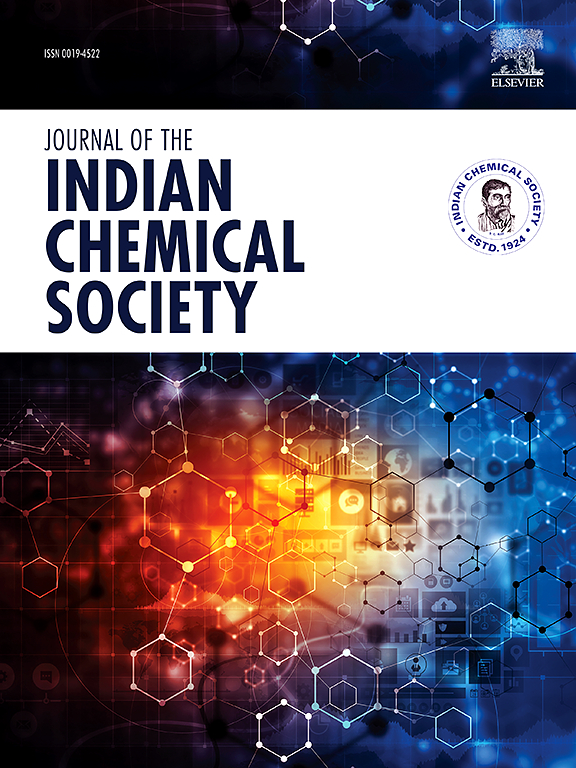铈(III)离子掺杂gd2 - xsi2o7荧光材料用于蓝光led和生物标记物的潜在指纹检测
IF 3.2
4区 化学
Q2 CHEMISTRY, MULTIDISCIPLINARY
引用次数: 0
摘要
采用煅烧水热法制备了Gd2-xSi2O7:xCe3+(0.02≤x≤0.12)蓝色发光材料。采用结构法和分光光度法分别对所选荧光粉的物相、形貌和发光性能进行了表征。制备的样品为单相,通过Rietveld细化确定其晶体结构为正交晶型。此外,通过BET分析确定了这些荧光粉中孔隙的平均直径为15.56 nm。由Gd2-xSi2O7的Ce3+样品的浓度XRD图引起的放大部分表明,随着Ce3+离子浓度的升高,衍射图一致地向2θ的低值偏移。Gd2-xSi2O7:xCe3+样品在370 nm的近紫外辐射下被激发时,有蓝光发射。在Gd2-xSi2O7基体中,激活离子之间的能量传递符合四极-四极相互作用。Ce3+离子在主晶格中的两个可能的阳离子位置可以用双指数拟合行为来解释。所制备的样品在设计磷转换蓝光,LED-B1(色纯度= 94.73%),LED-V1和LED-RGB1(色纯度= 94.72%)方面具有潜在的应用前景。蓝色发光荧光粉也被用来识别光滑表面上的潜在指纹。1、2、3级手印在紫外光下清晰可见,与背景对比良好。本文章由计算机程序翻译,如有差异,请以英文原文为准。
Cerium (III) ion doped-Gd2-xSi2O7 phosphor material for blue-LEDs and Bio-marker for latent fingerprint detection
Blue light-emitting materials Gd2-xSi2O7:xCe3+ (0.02 ≤ x ≤ 0.12) were synthesised hydrothermally followed by calcination. The selected phosphors' phase determination, morphology and luminescence properties were identified using structural and spectrophotometric investigation, respectively. The prepared samples were single-phase and the crystal structure was determined to be orthorhombic with the help of Rietveld refinement. Furthermore, the average diameter of the pores in these phosphors is determined to be 15.56 nm with the help of BET analysis. The zoomed part induced by concentration XRD patterns of the Ce3+ samples of Gd2-xSi2O7 indicates that the diffraction pattern exhibits a consistent shift towards a lower value of 2θ as the concentration of Ce3+ ion rises. Blue light emission is observed in Gd2-xSi2O7:xCe3+ samples when excited at 370 nm by Near-UV radiation. The energy transfer among the activator ions in the Gd2-xSi2O7 matrix is consistent with a quadrupolar-quadrupolar interaction. Two possible cationic locations for the Ce3+ ions in the host lattice can be explained with the help of biexponential fitting behaviour. The produced samples have potential applications in designing phosphor-converted blue light, LED-B1 (Color purity = 94.73 %), LED-V1 and LED-RGB1(Color purity = 94.72 %). The blue-emitting phosphors were also utilised to identify latent fingerprints on smooth surfaces. The level 1,2 and 3 fingermarks could be easily seen under UV light and exhibited excellent contrast with the background.
求助全文
通过发布文献求助,成功后即可免费获取论文全文。
去求助
来源期刊
CiteScore
3.50
自引率
7.70%
发文量
492
审稿时长
3-8 weeks
期刊介绍:
The Journal of the Indian Chemical Society publishes original, fundamental, theorical, experimental research work of highest quality in all areas of chemistry, biochemistry, medicinal chemistry, electrochemistry, agrochemistry, chemical engineering and technology, food chemistry, environmental chemistry, etc.

 求助内容:
求助内容: 应助结果提醒方式:
应助结果提醒方式:


